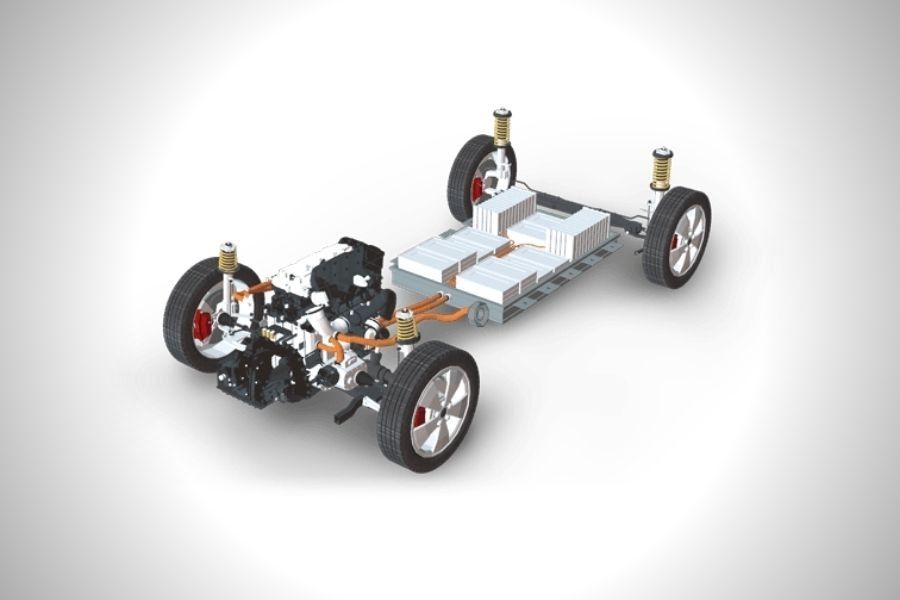What is a Mild Hybrid Vehicle?
A mild hybrid vehicle is a type of hybrid electric vehicle that uses lightweight hybridization to improve fuel economy and reduce emissions. Unlike full hybrids which have larger batteries that can power the vehicle solely on electricity, mild hybrids utilize a smaller battery and an integrated starter generator (ISG) to boost efficiency through regenerative braking and engine stop-start capabilities.
How does a Mild Hybrid System Work?
A Mild Hybrid Vehicles combines a small electric motor, typically anywhere from 5-20 kW, with a larger conventional combustion engine. The electric motor works together with the gasoline or diesel engine through the following main functions:
Regenerative Braking
The electric motor acts as a generator during braking to recapture kinetic energy that would otherwise be lost as heat. This regenerative braking charges the battery pack.
Engine Start-Stop
The system automatically shuts off the combustion engine at stops like traffic lights to eliminate idling fuel consumption. The electric motor immediately restarts the engine when the brake is released.
Boost Assistance
The electric motor provides torque filling and acceleration assistance to the internal combustion engine for better performance and responsiveness, especially from standstill. This downsizes the needed engine size.
Battery and Motors
Mild hybrids utilize a smaller lithium-ion battery, usually 0.5-1 kWh, and a brushless electric motor that is more compact and lightweight compared to full hybrid drivetrains. The battery charges via regenerative braking and the combustion engine.
Benefits of Mild Hybrid Technology
The main advantages of mild hybridization over conventional internal combustion engine vehicles include:
Improved Fuel Economy – Engine stop-start and boosting functions help reduce fuel use in city and highway driving for savings of 15-25% compared to non-hybrid vehicles.
Lower Emissions – By capturing otherwise wasted energy through regeneration and minimizing idle time, CO2 emissions are reduced by 10-15%.
Enhanced Driving Experience – The supplemental electric torque from the small motor improves acceleration feel from a stop as well as smoother engine restarts.
Downsized Engines – Mild hybrid systems allow for smaller displacement engines while maintaining performance expectations.
Low Cost – As the electric components are less complex than full hybrids, the additional cost of a mild hybrid system over a similar gas vehicle is only $1,000-$3,000, making the payback period short.
Real World Performance of Mild Hybrids
Several mainstream automakers now offer mild hybrid options in their vehicle lineups, proving the technology’s viability and acceptance. Some notable mild hybrid models on the road today delivering estimated fuel savings include:
Toyota Camry Hybrid – Available with a 2.5L 4-cylinder engine paired to an ISG, it returns over 40 mpg in combined driving for a savings of over 500 gallons of gas per 100,000 miles compared to the non-hybrid version.
Honda Insight – Produces up to 55 mpg highway with its 1.5L 4-cylinder and small electric motor. The driving range is extended by over 200 miles per tank compared to Honda Civics with conventional powertrains.
Kia Niro – Pairing a 1.6L GDI engine with a lithium-polymer battery and motor generator, this crossover SUV boasts up to 50 mpg combined while offering over 500 miles of driving range per fill-up.
BMW 330e – This plug-in hybrid luxury sedan utilitzes a 2.0L turbocharged 4-cylinder matched to an electric motor. It delivers the driving performance of the 3 Series along with the benefits of gas and electric power for a total driving range up to close to 20 miles solely on electricity.
Mild Hybrid Adoption Trends
Major automakers are continually expanding their mild hybrid offerings across brands, body styles, and price points in response to stricter emissions regulations and consumer demand for fuel-sipping capabilities. By 2025, it’s projected that over 20% of all new vehicles sold globally will have some level of electrification from mild hybrid systems. As the technology becomes standard issue in many common models, its affordability and simplicity make it an accessible gateway to hybrid ownership and a step towards fully electric drivetrains in the future.
*Note:
1. Source: Coherent Market Insights, Public sources, Desk research
2. We have leveraged AI tools to mine information and compile it

